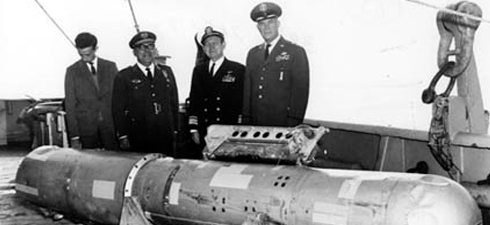If there's one thing the people of Palomares (Almeria) agree on, it’s a sense of weary satiation. After 45 years of bearing the cross of the U.S. thermonuclear bombs that fell in their area, they are fed up with politicians (except the local ones) and their eternal promises. They are tired of the technicians that are only starting now to abandon their obscurantism.
And they are shunning the press, too, angry at the negative coverage of the village. When a U.S. delegation visited the area on February 21 to discuss the cleanup of the contaminated zone, the villagers asked them for just one thing: to cart away the radioactive soil immediately. No other option is of any use to them. Once the soil is gone, the village council wants to build a theme park on the history of technology, from the Bronze Age to the nuclear era.
"Palomares is suffering a stigma that’s both social and economic," said the mayor of the village and the outlying hamlets, Juan José Pérez, unveiling the project to build the Park of Mediterranean Civilisations and their Technologies. The complex, half museum and half recreational zone, will go up in the area where one of the four bombs fell that January 17, 1966, when a huge B-52 bomber collided with its midair refuelling tanker high over Palomares.
Two alternatives will be looked into
Bordered by agricultural land to the north and south, an urban development to the west and the village cemetery to the east, the 40 hectare area is fenced off. Various signboards put up by the Spanish government’s Research Centre for Energy, Environment and Technology (CIEMAT) prohibit entry. “Outside the fence, you pass a Geiger counter over the ground and there’s no beep-beep," explained the representative of Ecologists in Action for the area, Igor Parra. "But inside it, depending on the zone, it starts to whistle," he added, flanked by the mayor of Palomares and by the paleontologist and holder of the Prince of Asturias Prize for Research, Eudald Carbonell.
The co-director of the Atapuerca Foundation of Burgos [which organises and supervises research into the origins of the earliest known hominids in Europe] may have the primary responsibility for the future park. "For now it’s just an idea on the drawing board," Carbonell clarifies. “I’m a specialist in prehistoric technology but very interested in how technology changes civilisations," he says. The Palomares area lies at the heart of the prehistoric El Argar culture, the most advanced urban civilisation in Europe 4,000 years ago. The park's historical journey would start there and end with nuclear energy.
Before the park is built the area must be decontaminated. The Americans want to clean it up, and the Spanish want them to take the dirt away. “Taking away the contaminated earth is the responsibility of the U.S. government, but also of the Spanish one," says Carbonell. For him, it’s the only way to compensate for the damage done to this countryside. Two alternatives will be looked into: decontamination there in the field, with the huge logistics effort that operation would entail, or shipping the soil to facilities in the U.S.
The residents have had enough
"This visit is a positive step, but will the Americans take away what they have to take away?" asks the ecologist, Parra. "We are about to enter the time for compensation," he adds. According to Parra, after the bombs fell the Americans carted away "a sixth of the problem, some 1,500 cubic meters of earth." Now they’ll have to carry away over 6,000. “The Palamares solution is not a budget problem. It’s an exercise in historical justice, and that has no price," says the environmentalist and resident of the neighbouring area.
The villagers are suspicious of everything. In a bar, several residents are watching news on television about the building of the park and the visit by U.S. technicians. “Let them come and take away the soil that’s already done enough damage," says Andrés, the son of the owner of the café 102 Tapas. The damage he’s referring to isn’t from the radiation from the plutonium. He’s speaking of the image of the area, which is being dragged through the mud. "I'm from here, like my whole family, and we're all healthy. My grandparents died at the age of 90,” he says.
Most of the villagers are far less sanguine. The mayor had already warned of this in the morning. "We have media from all over the world calling here all day and every day. The residents have had enough,” says Juan José Pérez.
Translated from the Spanish by Anton Baer
Was this article useful? If so we are delighted!
It is freely available because we believe that the right to free and independent information is essential for democracy. But this right is not guaranteed forever, and independence comes at a cost. We need your support in order to continue publishing independent, multilingual news for all Europeans.
Discover our subscription offers and their exclusive benefits and become a member of our community now!












